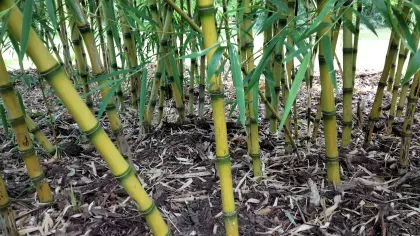
Giant bamboo
On this page
One of the tallest grasses in the world in the world, the giant bamboo can reach heights of 25 metres.
Like many species of bamboo, Gigantochloa verticillata grows incredibly quickly, with mature individuals growing at speeds of up to 30cm a day during its peak season.
This puts them in the fastest-growing species in the world, enabling them to outcompete other species in their race to reach the light at the top of the forest.
Native to the tropical monsoon forests of South-East Asia, giant bamboo is highly valued as a crafting material, used for everything from scaffolding to musical instruments.
As a species that grows very rapidly, and can regenerate from its roots after harvesting, giant bamboo and similar species are being explored as potential carbon stores to help combat climate change.
Plant description
Giant bamboo grows in clumps of tall, striped-green stems that can reach heights of over 25m. The stems are usually striped yellow and green. Branches grow from nodes on the stem, which occur in 50cm intervals. The leaves are lance-shaped, around 23cm and 3cm wide, and grow in clusters on branches that extend from the nodes. Flowers occur rarely and are formed of a cluster of small buds.



Plant uses
Food and drink
The young shoots of giant bamboo can be eaten as a vegetable while still tender.
Materials and fuels
Giant bamboo is used in Indonesia to make many different objects - including buildings, furniture, toothpicks and chopsticks.
Its stems are used to produce charcoal and biochar, a type of charcoal that is being used to enhance soil health for plants.
Did you know?
Other giant bamboo species in the same genus, like Gigantochloa apus and Gigantochloa atroviolacea, are used for weaving baskets and crafting musical instruments.
A recent study has found that charcoal made from giant bamboo could be used to purify biogas before it is used as fuel.
Giant bamboo forests are an important natural habitat for wildlife and can be vital for preventing lowland areas from flooding.
Giant bamboo typically lives for 50 to 60 years without flowering, until blossoming in its final few years before dying.
Where in the world?

Tropical monsoon forests across Southeast Asia
Find it in our gardens
Kew Gardens
A botanic garden in southwest London with the world’s most diverse living plant collection.
Location
View map of Kew GardensBest time to see
Our work
Bamboos are hard to identify and name correctly, but it's critical when making sure that commercially used bamboo is coming from sustainable sources.
Kew has worked with the International Bamboo and Rattan Organisation (INBAR) to publish the World Checklist and Atlas of Bamboos and Rattans. The list included many species that were not known before. Anyone working with bamboos will now easily be able to find the correct plant name, and confirm where the plants grow.
More about this plant
Other plants
More from Kew
Shop
Browse our range of bamboo products. Buying something from the Kew Online Shop supports our vital science work.

Kew Bamboo Mini Notepad
£5.00

Waterlily Bamboo Socks
£7.95





